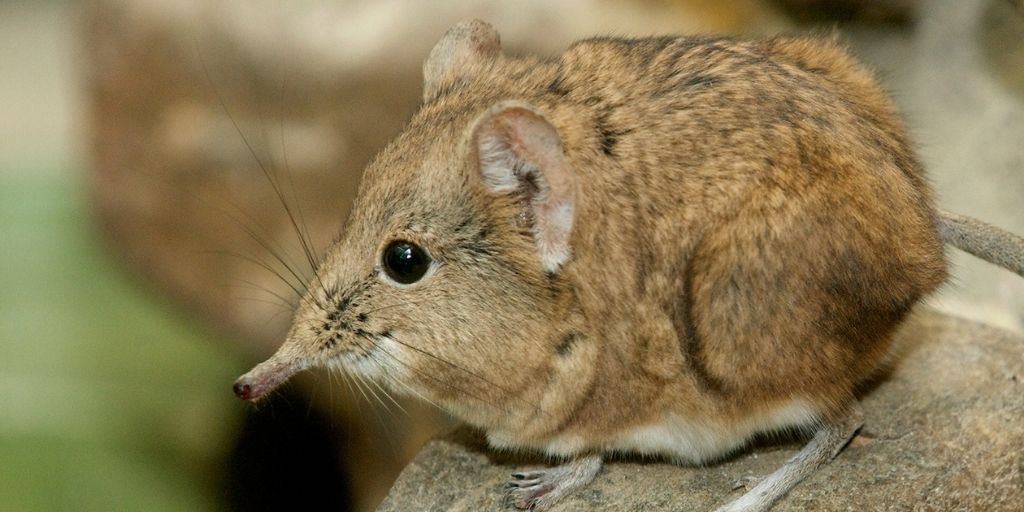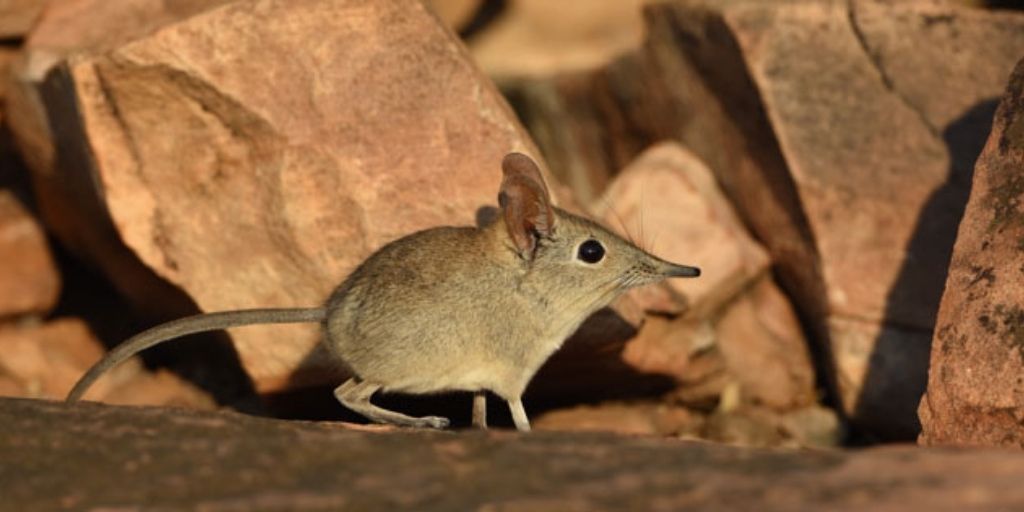The elephant shrew is also known as the jumping shrew. In Africa, elephant shrews are called sengis. They are one of the fastest small mammals on the planet. These tiny mammals belong to the family Macroscelididae. There are a total of 6 genera in the Macroscelididae family. And the 20 species of elephant shrew are divided into these six genera. These mouse-like creatures are native to Africa.
Our wildlife guide to the elephant shrew features all the important details of the animal. Let’s quickly get to the sections below for knowing more about the elephant shrews.
Skip to: Characteristics, Range & habitat, Diet, Behaviour, Fun facts, Video

- Latin name (genus): Elephantulus, Galegeeska, Macroscelides, Petrodromus, Petrosaltator, Rhynchocyon
- Family name: Macroscelididae
- Size: 10-30 centimeters
- Weight: 50-500 grams
Elephant shrew characteristics
Elephant shrews are called so because of their long noses that are similar to the elephant trunk. However, these shrews are small and look like rodents. They have scaly tails, long snouts, and comparably long legs than their body size. They use their long legs to jump while moving. It is exactly similar to that of a rabbit.
The average size of elephant shrews is 10-30 cm and their weight ranges from 50-500 g. Whereas, the short-eared elephant shrew is only 150 mm in size. The size of an elephant shrew’s nose varies in different species.
An elephant shrew has large canine teeth and high-crowned cheek teeth like ungulates (Zebra, Hippo, Antelope, etc.).
Range & habitat
Elephant shrews are native to the southern parts of Africa. However, they live in any type of habitat. The range of their habitat is from the Namib Desert to South Africa to thick forest regions.
However, different species of elephant shrews are spread across different regions of Africa. Let’s know more about some popular species of elephant shrews and know more about their range and habitat.
North African elephant shrew (Petrosaltator rozeti)
North African elephant shrew is also known as North African sengi. It lives in Algeria, Libya, Morocco, and Tunisia. They are distributed in northwestern Africa from northern Western Sahara to western Libya. Their habitat includes shrubby vegetation and deserts.
Somali elephant shrew (Galegeeska revoilii)
Somali elephant shrew or Somali sengi lives in the arid and semi-arid desert with rocky areas and sparse shrubs. They are mostly found in northern Somalia and the Horn of Africa. In 2020, they are also found in Djibouti and Ethiopia.
Short-eared elephant shrew (Macroscelides proboscideus)
The short-eared elephant shrew is also known as round-eared sengi. It lives in Botswana, Namibia, and South Africa. Its habitat includes subtropical or tropical dry shrubland, subtropical or tropical dry lowland grassland, and also hot deserts.
Namib round-eared elephant shrew (Macroscelides flavicaudatus)
Namib round-eared elephant shrew or Namib round-eared sengi is mostly found in the central Namib desert and southern Namibia.
Golden-rumped elephant shrew (Rhynchocyon chrysopygus)
Golden-rumped elephant shrew is the largest species of the elephant shrew. This endangered species lives in dense forests. Its habitat also includes coastal regions, dense-brush forests, and lowland semi-deciduous forests.
Four-toed elephant shrew (Petrodromus tetradactylus)
Four-toed elephant shrew or four-toed sengi is the only living shrew in the Petrodromus genus. It is only found in Central and Southern East Africa. Its natural habitat includes subtropical or tropical dry forests, montane forests, and moist savannas lowland forests.


Diet
Elephant shrews are insectivores. They mostly feed on insects, spiders, centipedes, millipedes, and earthworms. Some elephant shrew species also eat new leaves, seeds, and small fruits. However, most of the species feed on insects.
Behavior & lifestyle
Elephant shrews are diurnal animals. They remain active throughout the day. It is energetic and can’t be trapped easily. Moreover, it is very difficult to spot an elephant shrew. Its dusty brownish skin helps it camouflage in the surroundings and it is an expert at running away from threats. Elephant shrews use cleared pathways through the undergrowth and forage for insects throughout the day. They use the pathways to escape very quickly.
They aren’t social animals. Some species are found to be living in pairs. The species under Rhynchocyon genera dig small conical holes in the soil and live in it. Other species make use of natural crevices or make leaf nests.
A female elephant shrew gestates for 45-60 days. The female bears 1-3 offspring per year. After five days of their birth, the female sengi supplements the milk diet with mashed insects. The young sengis establish their own homes after 15 days of their birth.


Fun elephant shrew facts
Here is a list of “Top 5 Fun Elephant Shrew Facts“. You can read the list below.
- The scientific study revealed that elephant shrews are more closely related to elephants than shrews!
- Elephant shrew is the fastest of all small mammals. It can reach speeds of 28.8 kilometers/hour.
- The elephant shrews have relatively larger brains than other insectivores.
- The elephant shrews living in pairs don’t care much about each other. They live in pairs for the sake of reproduction!
- Elephant shrews can regulate body temperature at 35 °C by using EWL (evaporative water loss) technique.
Meet the elephant shrew
Here at SafarisAfricana, you can read such amazing facts about Safari Animals.
You can read about The Smallest Mammals In The World here.
Did you enjoy learning more about the elephant shrew? Have you ever met this unique creature face-to-face? Tell us about your elephant shrew experience in the comment section below. Because those who care share!
References
- “Elephant Shrew”. African Wildlife Foundation. Retrieved 1 February 2010.
- “Sengis (Elephant-Shrews)”. California Academy of Sciences. Archived from the original on 10 May 2013. Retrieved 1 October 2012.
- “New Species Of Giant Elephant-shrew Discovered“. Science Daily. February 2008. Retrieved 1 February 2010.
- “New sengi species is related to an elephant but small as a mouse“. Los Angeles Times. June 2014. Retrieved 1 June 2014.
- Iwaniuk, A.; Kaufman, J.A.; Turner, G.H.; Holroyd, P.A.; Rovero, F.; Grossman, A. (2013). “Brain Volume of the Newly-Discovered Species Rhynchocyon udzungwensis (Mammalia: Afrotheria: Macroscelidea): Implications for Encephalization in Sengis“. PLOS ONE. 8 (3): e58667. doi:10.1371/journal.pone.0058667. PMID 23516530.
- Encyclopedia of Animals. Online database: EBSCO Publishing.
- Rathbun, Galen B. (1984). Macdonald, D. (ed.). The Encyclopedia of Mammals. New York: Facts on File. pp. 730–733. ISBN 978-0-87196-871-5.
- Conniff, Richard. Shrewd Configuration, Smithsonian, June 2005. pp. 26-28.
- “Short-eared elephant-shrew (Macroscelides proboscideus) – A “living fossil” from the Namib-desert“. Natur Spot. Archived from the original on 19 July 2011. Retrieved 1 February 2010.
- Rathbun, Galen B. (September 1992). “The Fairly True Elephant-Shrew”. Natural History. New York. 101.
